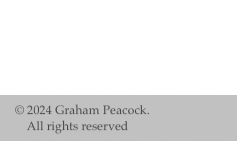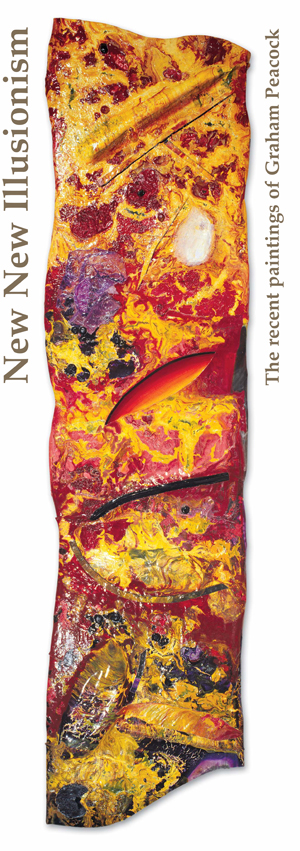 |
 |
||||
Graham Peacockby Kenworth W. Moffett “I am Nature” Jackson Pollock I first met Graham Peacock in 1980 on a tour of Edmonton studios. He stood out as a strong personality, intelligent, with a cheeky British sense of humor. There was a set of drums in the studio and he told me that he played in a rock band. He seemed full of energy and artistic ambition. Our next encounter was at the Emma Lake workshop of the following year held in Saskatchewan. I had been invited critic and was there with the painter, Lucy Baker. Peacock was a participant. We all got to know each other quite well. He had been profoundly inspired by Larry Poons’ cascade paintings of the 70’s with their radical, large-scale experimentalism. Peacock was raking and squeegeeing paint onto big, heavy ply rugs and other unlikely surfaces, trying anything he could think of to find a new way. I loved his all-out, go for broke approach. He didn’t care what others thought and he was not afraid to make a fool of himself. He was going to be himself no matter what. Peacock’s revelation came in 1982 in a series of blue and white, shaped pictures which he dubbed the “Polo” series. They showed a nasty, jagged, small scale drawing which he had achieved by working on the floor pouring one flood of color over another and, so controlling the drying of each, as to get a crackling, electric, crazing, revealing sharply contrasting colors from below. These Polo pictures had harshness, a dryness, and an edgy “ugliness”. They were raw and intense and they felt very original. They went completely against the prevailing style of those who saw themselves as carrying on the tradition of Abstract Expressionism and Color Field painting: that of Jules Olitski with its exquisite refinement and sublime beauties. Peacock was confirmed in his heresy by Lucy Baker whose artistic personality was even less in sympathy with Olitski’s than his and whose work of that time also challenged to Olitski’s hegemony. Here, in 1982, was the beginning of New New painting. New New is a group of 12 painters who represent the latest wave of the post-war, modernist mainstream. They all have been influenced by Color Field and especially Olitski. But they have gone on to create something new by reaffirming the painting of Jackson Pollock and the Abstract Expressionists. Like the latter and like the early non-objective painters such as Kandinsky and Mondrian, New New proclaim the spiritual and love freedom more than beauty. Another crucial factor for the New New has been the development of plastic paint. The New New generation was the first to have available to it, almost from the first, acrylics, as a full-bodied, painting medium, with all the capabilities of oils and much more. Part of the excitement of the New New painters lie in their audaciously experimental approach to this brand new, still very much evolving, medium. And no one has plunged into it with more abandon than Peacock. No one has searched out and discovered so many of its secrets and possibilities. He is the only member of the New New to make his own acrylic gel and from the start he has been at the forefront of the new technology. He could be called a master alchemist turning plastic into artistic gold. In his book, What Painting Is, James Elkins uses an extended analogy between painting and alchemy to show how the art of painting, at it’s deepest level, is about the ability to think and feel in paint, which amounts to the painter’s intensely sensual, imaginative and mystical identification with this most magical of all substances. Elkins writes “paint has its own meaning, entrancing, utterly addictive, replete with expressive force, that can keep hold of an artist attention for an entire lifetime”. “There is no meaning that cannot seem to flow from paint itself, from the spectator’s standpoint, looking at a finished painting, marks can become eloquent records of the painters body, and through the body come indescribable but powerful ideas about the painter’s feelings and moods. Paint incites motions, and through them it implies emotions and other wordless experiences. That is why painting is a fine art; not merely because it gives us trees and faces and lovely things to see, but because paint is a finely tuned antenna, reacting to every unnoticed movement of the painter… fixing the faintest shadow of a thought in color and texture”. For Peacock, finding and staying in touch with his higher, inner self, and a passionate, mind-body, responsive dialogue with the medium, are identical. He has created his own personal “craft” in a brand new medium. He begins working on the floor. A canvas is rolled out in a huge trough which can be as large as 60 ft long, 7 ft wide. He then pours different levels and controls the drying process of each with a system of fans. Next he then staples the length of canvas to the wall for study. Sometimes he takes it down and puts it on the floor again to do more pourings. If he is satisfied that the length has possibilities, he begins the second phase, inpainting with a brush or collaging on pieces of dried paint as different colors and textures. Then he “finds” his pictures in the length. This process has been succinctly described by the Emersonian poet, the late A.R. Ammons: Finally, Peacock decides the orientation of the picture, the way that it will hang on the wall. Often several orientations work equally well. Unlike “series” painters, who take one idea and drive it home before moving on to another (Morris Louis, Kenneth Noland or Bruce Piermarini are perfect examples), Peacock unfolds his art in many directions at once. If he is sometimes less consistent, he also keeps more balls in the air at the same time than almost anyone else. His oeuvre develops not as a series of distinct campaigns but as a continuous, ever more encompassing expansion. Peacock’s way of working makes his pictures seem like the result of natural forces, especially the flow and viscosity of paints and gels. This kind of “process painting” first appeared, full blown, in Pollock’s drip style of 1947-1950, and was developed further by Morris Louis, Jules Olitski, Larry Poons and others. The painter so organizes himself as to let the medium lead, to let the painting “paint itself”. The painter trusts his genius, surrenders traditional forms of graphic control, and admits more and more chance and chaos into the process. In this way the painter “keeps it real”, keeps his own reactions fresh, spontaneous, in-the-moment, and opens himself to the unexpected. In one sense, the process painter can be said to be more passive than the traditional painter, but, in another sense, the process painter is a god-like creator, orchestrating nature itself. With a little creative effort, any motivated viewer can come to see a process painting as an act of will, a personal statement, a living presence, a sublimated self. Peacock’s paintings are nature, yet nature intensified and perfectly focused by the human mind. And amazingly enough, the more Peacock lets paint and natural processes rule, the more recognizable, but not consciously intended, images, constellations of images, and even narratives, appear: a face, a bird, a dragon, a landscape, a battle, or anything else conceivable. Different viewers often see different images but there is also much agreement. Sometimes these “emergent” images even provide an organizing focus, or one way to focus, the picture. They convey a sense of infinite and fluid meaning. They help the viewer get involved and actively recreate the work. They evoke the mystery and wonder of our being-in-the-world. In some instances, Peacock makes the whole picture shape suggest an image: a human profile or body, an animate or unanimated object like a fish or a surf board. This free play with the world’s forms is everywhere in Peacock’s art. It makes moot terms like “abstract” and “non-objective”. No one has pushed process painting as far as Peacock. He is a radical naturalist, an unapologetic materialist, and a shameless sensualist. It is the genius of his art that such an extravagantly physical outpouring lives so wholly in the spirit. Each picture a singular, autonomous, spiritual entity, facing us, speaking emotional truth. |
|||||
 |
|||||